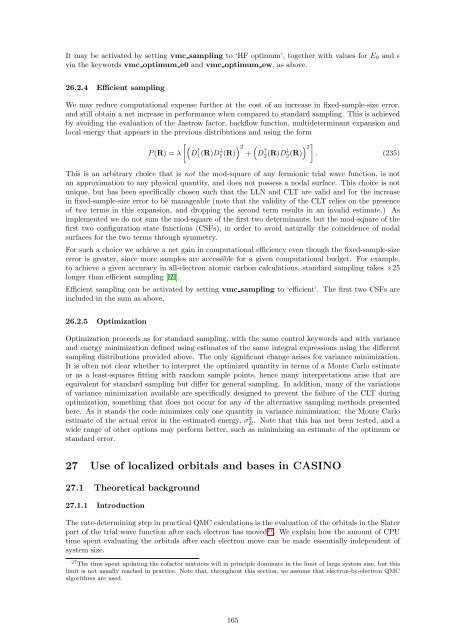CASINO manual - Theory of Condensed Matter
CASINO manual - Theory of Condensed Matter
CASINO manual - Theory of Condensed Matter
You also want an ePaper? Increase the reach of your titles
YUMPU automatically turns print PDFs into web optimized ePapers that Google loves.
It may be activated by setting vmc sampling to ‘HF optimum’, together with values for E 0 and ɛ<br />
via the keywords vmc optimum e0 and vmc optimum ew, as above.<br />
26.2.4 Efficient sampling<br />
We may reduce computational expense further at the cost <strong>of</strong> an increase in fixed-sample-size error,<br />
and still obtain a net increase in performance when compared to standard sampling. This is achieved<br />
by avoiding the evaluation <strong>of</strong> the Jastrow factor, backflow function, multideterminant expansion and<br />
local energy that appears in the previous distributions and using the form<br />
[ ( ) 2 ) ] 2<br />
P (R) = λ D ↑ 1 (R)D↓ 1 (R) +<br />
(D ↑ 2 (R)D↓ 2 (R) . (235)<br />
This is an arbitrary choice that is not the mod-square <strong>of</strong> any fermionic trial wave function, is not<br />
an approximation to any physical quantity, and does not possess a nodal surface. This choice is not<br />
unique, but has been specifically chosen such that the LLN and CLT are valid and for the increase<br />
in fixed-sample-size error to be manageable (note that the validity <strong>of</strong> the CLT relies on the presence<br />
<strong>of</strong> two terms in this expansion, and dropping the second term results in an invalid estimate.) As<br />
implemented we do not sum the mod-square <strong>of</strong> the first two determinants, but the mod-square <strong>of</strong> the<br />
first two configuration state functions (CSFs), in order to avoid naturally the coincidence <strong>of</strong> nodal<br />
surfaces for the two terms through symmetry.<br />
For such a choice we achieve a net gain in computational efficiency even though the fixed-sample-size<br />
error is greater, since more samples are accessible for a given computational budget. For example,<br />
to achieve a given accuracy in all-electron atomic carbon calculations, standard sampling takes ×25<br />
longer than efficient sampling [69].<br />
Efficient sampling can be activated by setting vmc sampling to ‘efficient’. The first two CSFs are<br />
included in the sum as above.<br />
26.2.5 Optimization<br />
Optimization proceeds as for standard sampling, with the same control keywords and with variance<br />
and energy minimization defined using estimates <strong>of</strong> the same integral expressions using the different<br />
sampling distributions provided above. The only significant change arises for variance minimization.<br />
It is <strong>of</strong>ten not clear whether to interpret the optimized quantity in terms <strong>of</strong> a Monte Carlo estimate<br />
or as a least-squares fitting with random sample points, hence many interpretations arise that are<br />
equivalent for standard sampling but differ for general sampling. In addition, many <strong>of</strong> the variations<br />
<strong>of</strong> variance minimization available are specifically designed to prevent the failure <strong>of</strong> the CLT during<br />
optimization, something that does not occur for any <strong>of</strong> the alternative sampling methods presented<br />
here. As it stands the code minimizes only one quantity in variance minimization: the Monte Carlo<br />
estimate <strong>of</strong> the actual error in the estimated energy, σ2<br />
¯<br />
E<br />
. Note that this has not been tested, and a<br />
wide range <strong>of</strong> other options may perform better, such as minimizing an estimate <strong>of</strong> the optimum or<br />
standard error.<br />
27 Use <strong>of</strong> localized orbitals and bases in <strong>CASINO</strong><br />
27.1 Theoretical background<br />
27.1.1 Introduction<br />
The rate-determining step in practical QMC calculations is the evaluation <strong>of</strong> the orbitals in the Slater<br />
part <strong>of</strong> the trial wave function after each electron has moved 27 . We explain how the amount <strong>of</strong> CPU<br />
time spent evaluating the orbitals after each electron move can be made essentially independent <strong>of</strong><br />
system size.<br />
27 The time spent updating the c<strong>of</strong>actor matrices will in principle dominate in the limit <strong>of</strong> large system size, but this<br />
limit is not usually reached in practice. Note that, throughout this section, we assume that electron-by-electron QMC<br />
algorithms are used.<br />
165

















